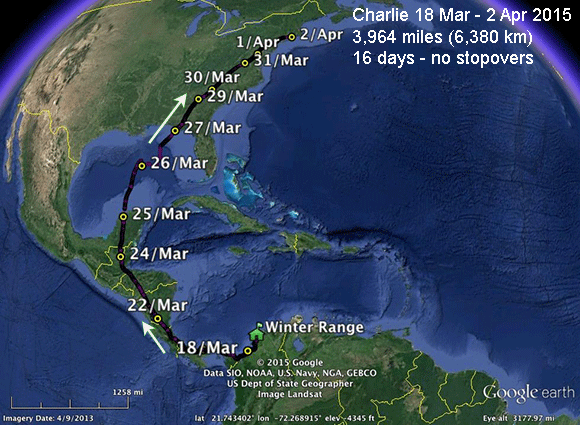 |
Spring migration - 2015
This is turning out to be a season of big surprises.
Charlie left his wintering waters in northern Colombia and wandered south. That looked a bit strange, but he turned around and then moved kinda sorta north-ish. So it looked like he was going to do what we expected--go home pretty much the same way he came south. At that point we lost contact with him. Three days later he checked in again, from Panama! A fair numnber of mid-west Ospreys get to and from South America via Central America, but we've only seen one east-coast bird do this. The difference was that the bird that did go home via Central America went south that way. We have never seen an adult go south via the normal Cuba-Hispaniola and then return via Central America. We did have one mid-west bird do this (south via Cuba and north via Central America).
Scroll down for Charlie's 2014 maps starting in 2014.
Skip to Fall 2014 migration
Skip to Spring 2015 migration
testlink
|
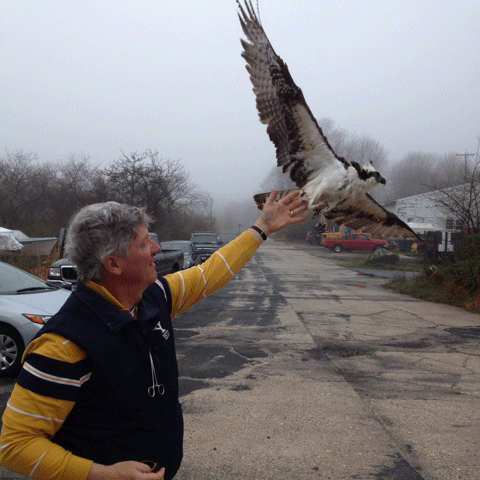 |
Charlie...
...is an adult male Osprey who has been nesting for years on the western end of Fishers Island at the local recycling cener.
He was named "Charlie" in honor of Charlie Ferguson, son of Henry L. Ferguson for whom Fishers Island's remarkable cultural and natural history museum was named. Charlie Ferguson was president of the Museum for 25 years until his retirement in 2003.
The female was banded almost 14 years ago as a nestling by Gerry Mersereau in Groton, CT, about 6 miles from Charlie's nest in July of 2000.
Scroll down for a brief bio and Charlie's maps from 2014...
Or jump ahead to the 2015 spring migration.
|
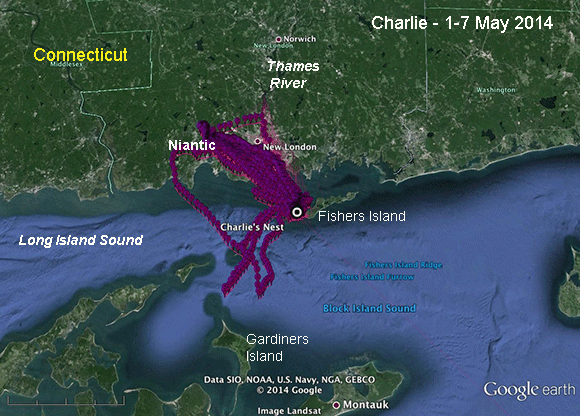 |
1-7 May
This was a total surpise--Charlie commutes to Connecticut on a very regular basis! He did make a couple of junkets south towards Gardiners Island, where, in the halcyon pre-DDT days, 300 pairs of Ospreys nested in the largest Osprey colony ever recorded.
Apparently, the results of the two missions were not impressive enough to break Charlie of his CT habit.
He did most of his fishing during this time on the Niantic River, although he did fish some on the Thames River.
|
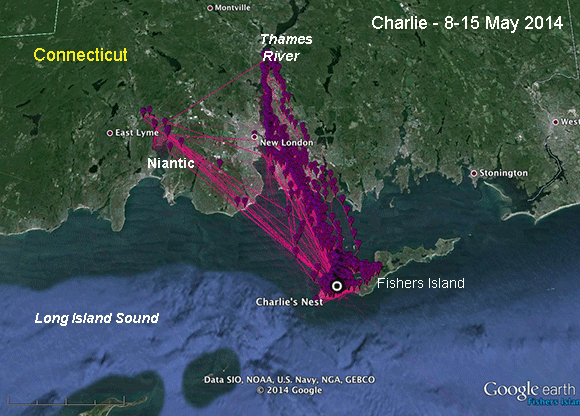 |
8-15 May
Charlie has shifted his attention to the Thames River with only a couple of trips to the Niantic.
|
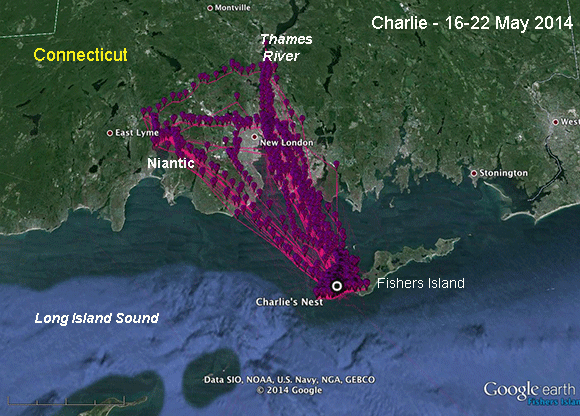 |
16-22 May
More of the same here. Charlie's emphasis is on the Thames, but he is still checking out the Niantic.
|
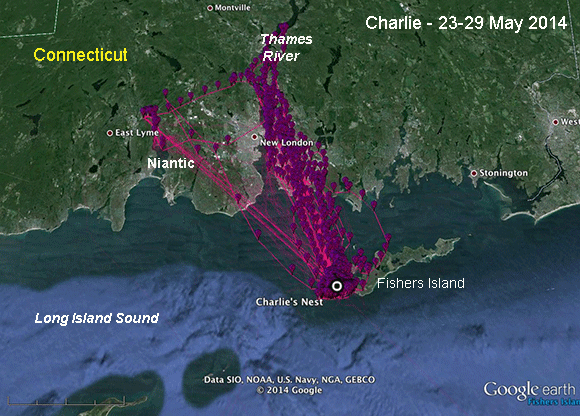 |
23-29 May
The action now is clearly up the Thames. This week, he's fishing a bit farther up the Thames than previously.
|
 |
30 May-6 June
Same story this week, with only one trip over to the Niantic, just to test the waters, presumably. Again, whatever he found-or rather didn't find-convinced him that the Thames is where the action is.
|
\
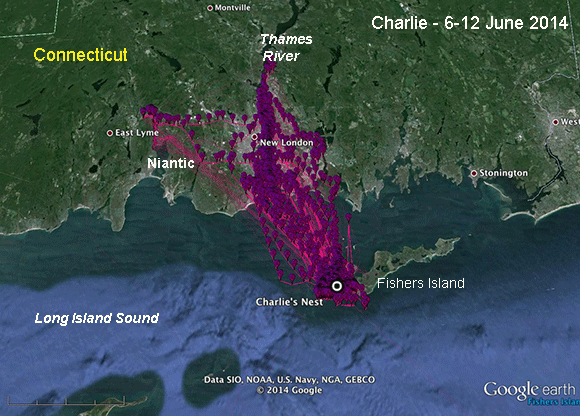 |
6-12 June
Lots of time fishing up the Thames above New London, with one junket over to the Niantic River.
|
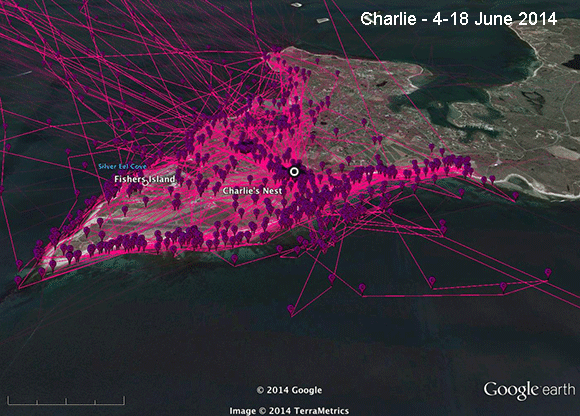 |
4-18 June - Near-shore fishing
While Charlie was doing most of his foraging over in Connecticut, he began spending more time close to home, fishing along the western shore of Fishers Island, and spent almost no time on the eastern two-thirds of the island.
In the second half of June, he only made 5 trips over to Connecticut.
|
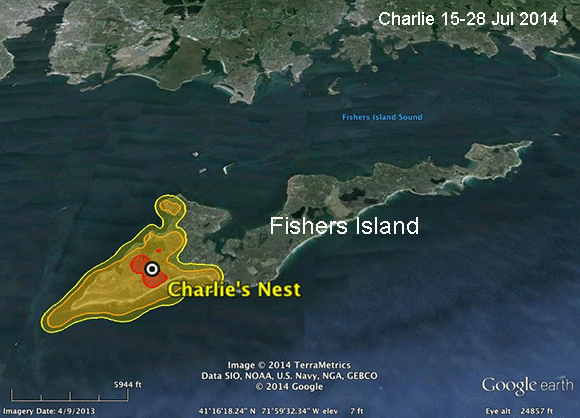 |
Late July
By the beginning of July, Charlie had pretty much stopped his commuting over to Connecticut.
Here is the range map for Charlie for the 2nd half of July. The red area is where 50% of his locations were, orange is 95%, and yellow is 98%. He only made one trip to Connecticut during the month, which tells us that some sort of fish became available around Fishers, or the fish he had been taking along the Thames and Niantic Rivers became less available, or both.
|
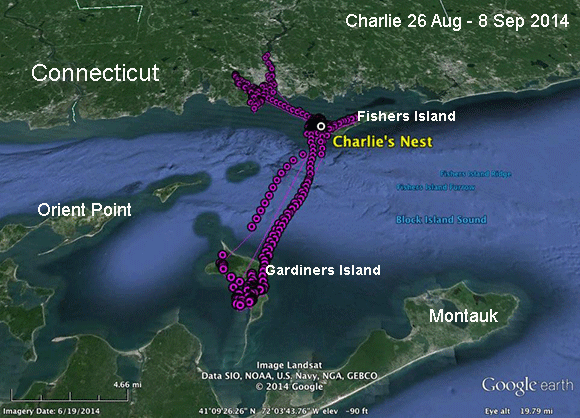 |
Packing for the winter
These are Charlie's movments for the 2 weeks prior to his fall departure. Earlier in August he made 4 trips to Connecticut and one during these 2 weeks.
On the 7th and 8th of September, Charlie made a couple of trips to Gardiners Island, once home (pre-DDT) to 300 pairs of Ospreys! His former neighbor Edwin spent quite a bit of time on Gardiners over the course of the summer. It's a 10-mile trip from Fishers to Gardiners.
|
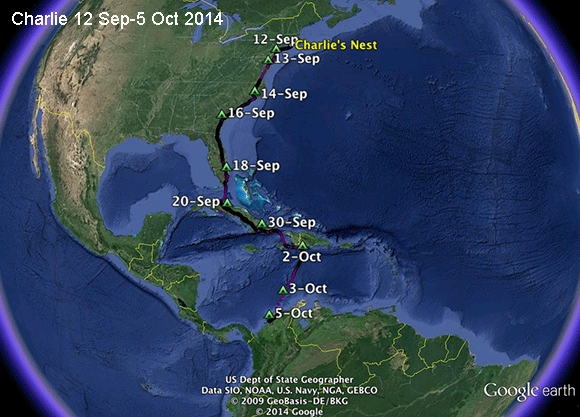 |
Fall migration 2014
The full migration is shown in this map. Scroll down for details.
Charlie took off from Fishers Island on 12 September, which is towards the end of the bell curve for departure for adult males from New England starting their migrations.
24 days later, he was in northern Colombia. This turned out to be his winter range.
|
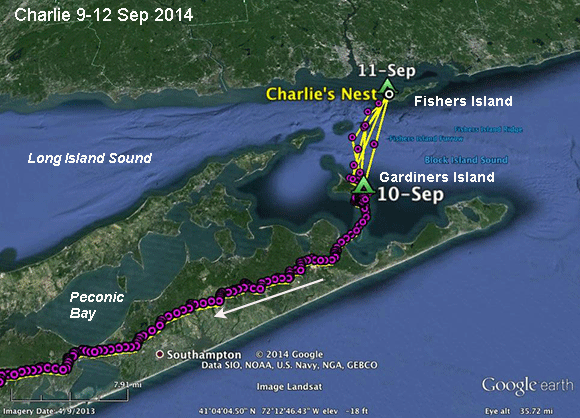 |
Departure
Just before he left he flew down to Gardiners at 9:30 on the 9th. He flew back at 6:30 PM. On the 10th he flew back to Gardiners, again at 9:30 (a regular commuter) and back to Fishers on the 11th at 5:25 PM. He left Fishers at 6:55 and got to Gardiners where he spent a couple of hours before setting out for South America at 9:30.
This is his first trip with a transmitter, so we don't know where he's going. But he does.
|
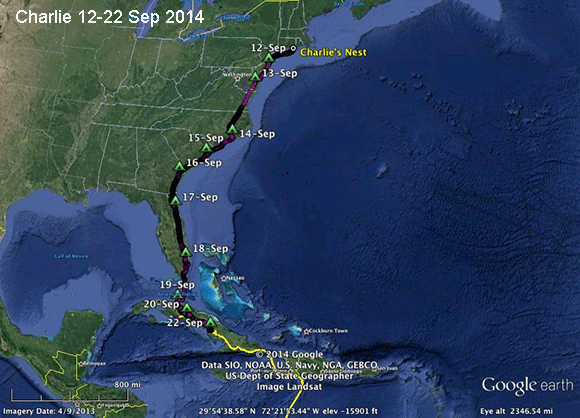 |
Into Cuba
Charlie's trip from Fishers Island to Cuba was very uneventful and exactly what we expect from adult Ospreys. He pretty much hugged the coast and had decent enough weather the whole way down, so he didn't stop for any lay-overs en route.
The 13th was a big day. He left his roost in Delaware around 6:40AM, which is really early and suggests strong tail winds. By the time he settled down to roost just a few miles north of North Carolina's Outerbanks near Cape Lookout, he had traveled 295 miles (475 km).
|
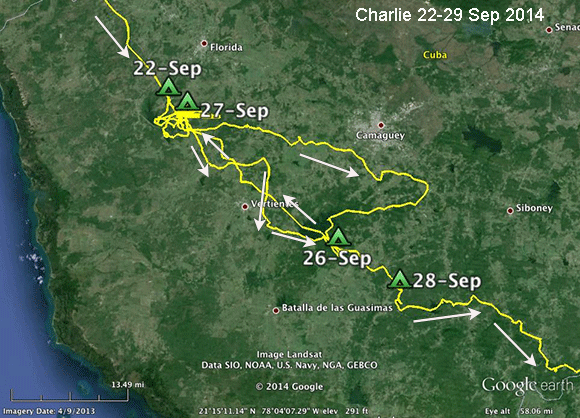 |
Five days for refueling
From the 23rd to the 27th, Charlie spent most of his time at a couple of reservoirs in central Cuba. He made one loop out south of Camaguey (we've had several birds stop around here), backtracking to the reservoirs where he spent most of these five days. On the 28th he got going again.
|
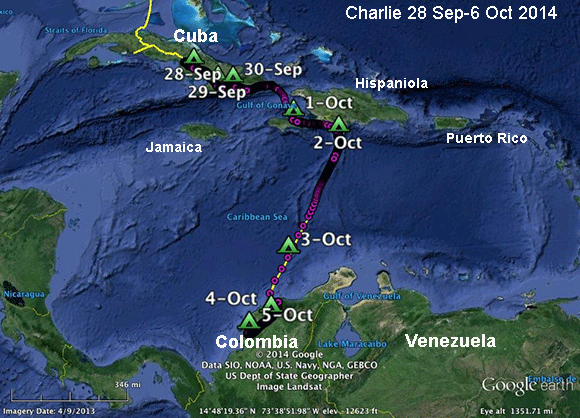 |
Across the Caribbean
After his stopover in Cuba, it was all migration for the next eight days. His track across the Caribbean is one of the straightest I've ever seen, which suggests he knew just where he was going and either didn't have much wind, or was correcting very accurately for wind drift.
|
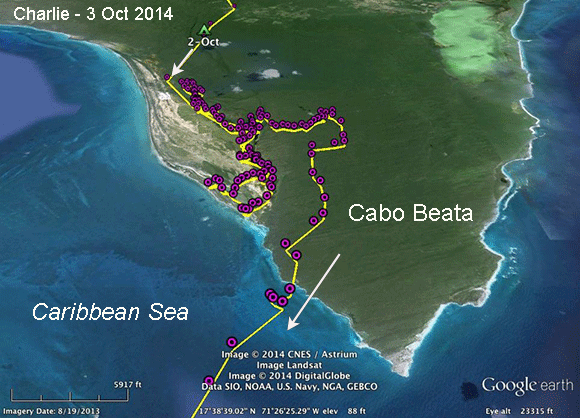 |
Departure from Hispaniola
Charlie left the Dominican Republic from the southern most bit of land on the Island of Hispaniola. This is what almost all the adults do each fall. If you ever wanted to see a whole lot of Ospreys, this would be the place to be!
Charlie left his October 2nd roost at 9:25 and spent two and a half hours fishing along some mangrove bays on the western side of Cabo (Cape) Beata. He headed south for keeps at 12:00 PM, leaving the D.R. behind at 12:15.
17 hours and 20 minutes later he made landfall in Colombia after flying just over 500 miles (about 800 km). He averaged a speedy 29 mph (46.4 kph).
|
 |
Arrival in South America
Charlie is one of only two (if I remember correctly) of our Ospreys to turn west after arriving on South America's northern shore. All the others worked their way east into northern Venezuela or points south and east of there.
|
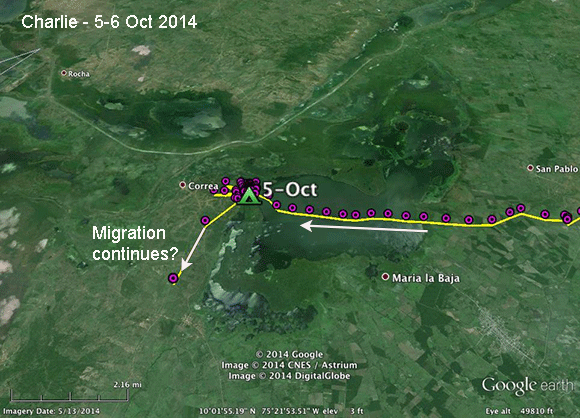 |
Are we done yet?
This looks like a good place for Charlie to spend the winter, but our last 2 locations look like he may still be on the move. Or, he may be just moving around his regular winter range. He certainly looked like he was headed here from the moment he left Hispaniola.
Stay tuned!
|
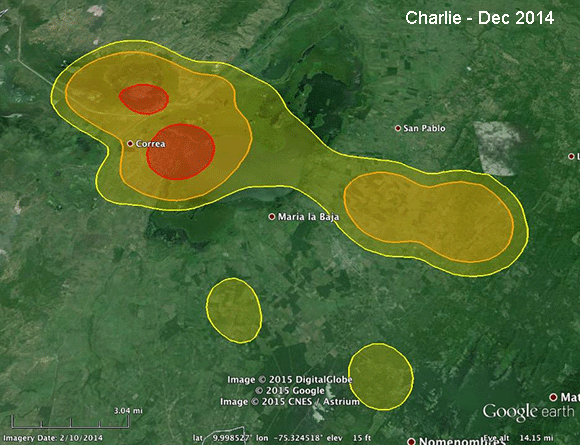 |
Yes, we're done.
This is, indeed, Charlie's winter range. He's in the lower Magdalena River valley in an area that looks like it's almost as much water as land. What could be better for a wintering Osprey?
The map shows the "kernel home range" analysis of his locations for December. The red area represents 50% of his locations. Orange is 95%, and yellow is 99% of his locations for the month. The red area probably represents most of his roosts, orange mostly where he was hunting.
|
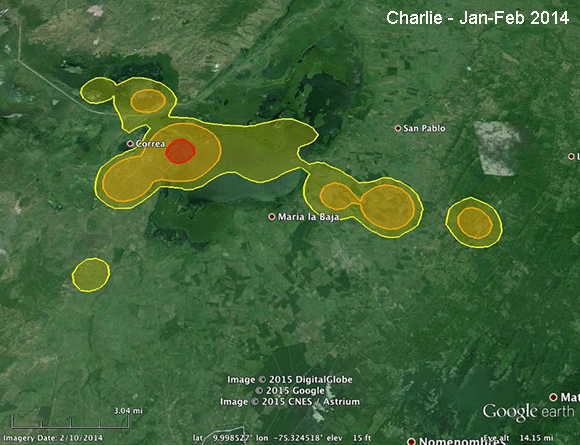 |
Winter range
Here's the same kernel range analysis of Charlie's locations for January and February.
|
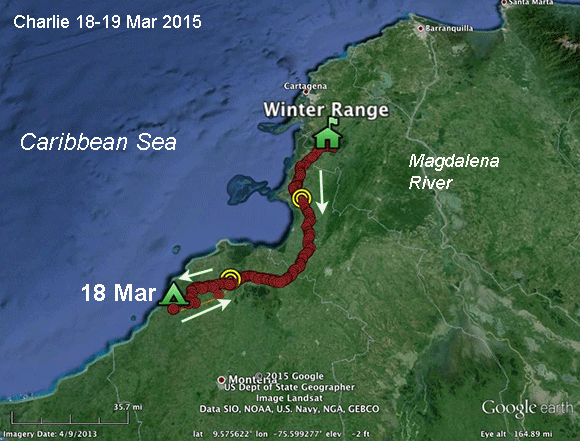 |
Heading south?
Charlie took off on the 18th heading south! This wasn't what we expected, obviously. On the morning of the 19th he retraced his track a bit, so it looked like he had come to his senses.
|
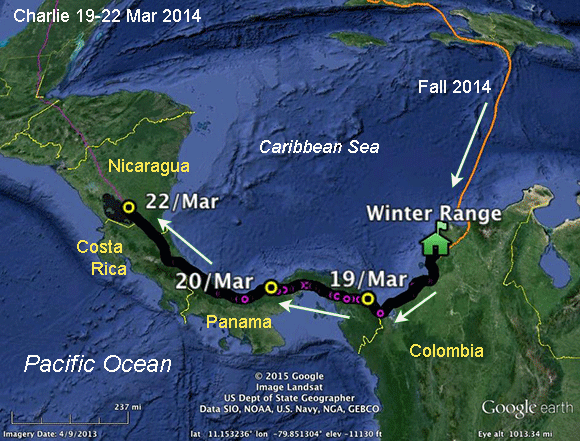 |
Panama?!!
This is pretty wild. It makes no sense for an Osprey that came into S.A. from Haiti and the D.R. to head north via Central America. But this is a year where things aren't making sense.
|
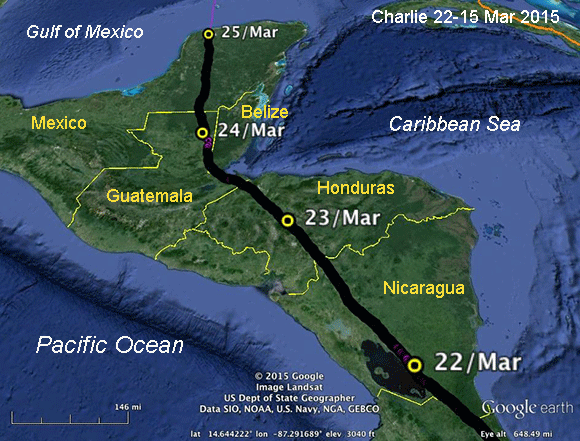 |
Yucatan-now what?
Five countries in three days. Not bad.
So what next? The "logical" move would be to head over to Cuba and then up to Florida, but while an Osprey has some sort of world map, it can't make the kind of logical decisions we would make in a situation like this. Charlie is driven to go north. At this point he has no option but to head out over the Gulf of Mexico.
|
 |
Across the Gulf of Mexico
Charlie did the obvious thing and pushed on heading north across the Gulf of Mexico.
The crossing was 855 miles (1,375 km). He averaged 24 mph (38 kph).
85% of of the altitudes for 685 locations over the water were below 310 ft (100 m) above sea level. 61% were from sea level to 930 ft (300 m). The highest point during the crossing was 1,764 ft (569 m).
He arrived in Florida at 9:40 pm. He had a bit of a sleep-in and was off again the next morning around 8:25 am.
The last point on this map was around 4 pm on the 28th. He kept flying a while after that, so the last point was not his roost for the day.
|
 |
Mystery at sea
Here's a close-up of a very strange track across the Gulf of Mexico. Well into the night of the 26th, Charlie was heading northeast. At 10 pm he made a very abrupt turn and headed due south. Then he zigs and zags around for 8 hours. At 6 am he made another sharp turn and began heading north. At 12:53 he made another rather sharp turn and fell into the exact path he would have been on had he not made the big overnight detour.
The obvious explanation for the wandering is that he got on a boat. I'll wait for my regular team of mariners to chime in on whether this makes sense, but in the mean time, it's the only logical explanation I can come up with.
What is most amazing, almost staggeringly so, is when he picks up the route he was on the night before. Could it possibly be that he somehow projected his path and knew when he was back on it? For that to happen, some navigational skills that I cannot even conceive of would have to come into play.
Never a dull moment looking at these maps!
|
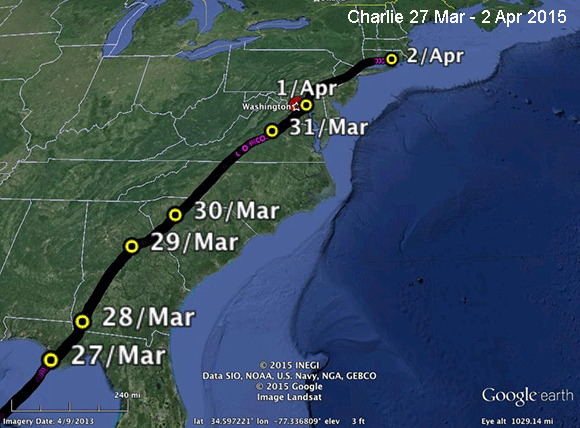 |
A quick trip home
Charlie finished his spring migration in a hurry with the help of some strong southerly tail winds on the 31st and 2nd. Other birds moving north at the same time also were speeding north, occasionally hitting ground speeds of 50 mph!
|

